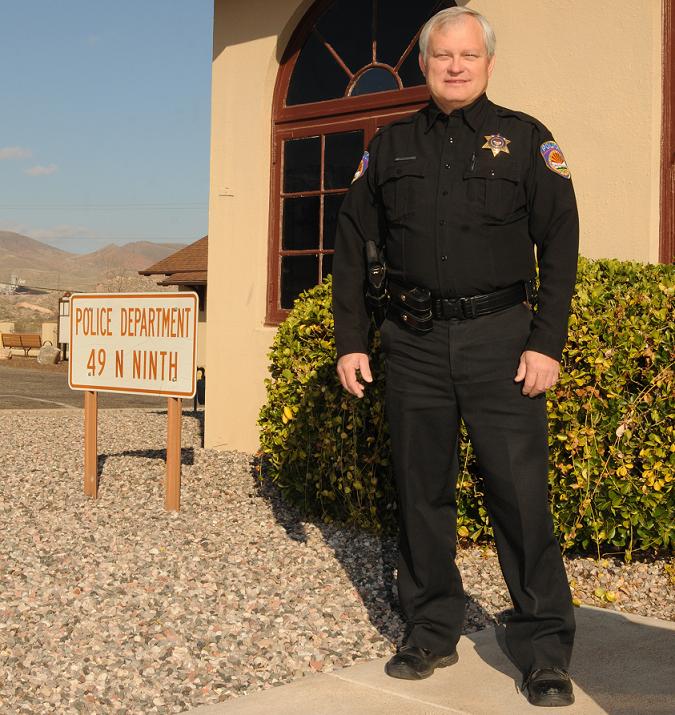Clarkdale Police Chief Pat Haynie was sprinting up a hill, pushing himself June 8 following a long distance run with Clarkdale Police Academy Explorers, a youth group sponsored by Clarkdale Police Department that trains on police procedure.
Suddenly he collapsed face down in the dirt. Climbing to his feet, he told officers standing nearby he was alright.
“The first thing I remember is I had a horrible headache and a horrible neck ache,” Haynie said. “It was the worse headache I’d ever had in my life.”
He recalls thinking to schedule an appointment with his chiropractor, but it was soon obvious spinal adjustments would not help. He began to repeat himself, so much so administrative assistant Jan Boyd insisted he get to the hospital immediately. An ambulance was called.
Later in the emergency room, Town Manager Gayle Mabery insisted doctors give Haynie a CT scan.
“That’s when they discovered the aneurysm and I was immediately flown out of here,” Haynie said.
“She probably saved my life,” he said. “I didn’t want to go. I’d never had major illness in my entire life.”
A weakened blood vessel in his brain ballooned, then ruptured. During surgery to repair the damage, doctors found seven more aneurysms that could have burst at any moment. They managed to repair all the other damaged blood vessels, any one of which could have killed him.
“I was a ticking time bomb,” Haynie said.
He remembers very little of the incident and much of what followed is unclear in his mind. It took weeks of rehabilitation before his thinking returned to normal.
An estimated 50 percent of people who suffer the same type of injury as Haynie die within three months. Another 25 percent suffer some type of permanent disability, according to the National Center for Biotechnology Information. Haynie beat the odds.
“I’m a miracle patient,” he said.
Residual effects of the chief’s brain injury linger. His short-term memory took the worst hit, sometimes causing him to forget what he was doing within minutes, especially when he’s working around the house.
At Clarkdale Police headquarters, however, the story is different. Comfortable in the place he spends the majority of his time, Haynie said he always feels more at home when he is working. His injury seems to cause fewer problems when he’s in uniform.
Based on his outstanding progress, doctors and Mabery finally decided he was able to return to work three months ago. He resumed his responsibilities as chief in November, earlier than his doctors predicted but later than he wanted.
“I’m at least three months ahead of schedule,” he said.
His recovery has been so complete, Haynie’s surgeons decided he will not need the follow-up treatment normally scheduled for patients who suffer the same type of injury. His next checkup is in about a year.
Since returning to the force, Haynie trained and became certified again in emergency response driving. He trained with Jerome Police Chief Alan Muma to master the way he handles his service pistol, actually improving his marksmanship from before the surgery.
He takes more notes these days to remind himself of the conversations he has and the decisions he makes.
He said he won’t push himself so hard anymore and took steps to reduce the stress in his life. With some regret, he chose to stop accepting at-risk foster children into his home, some of the most troubled kids in the system.
Among the dozens of children he helped in recent decades, several stay in close touch. Unmarried without children of his own, Haynie counts these foster children among his closest family members. Pictures of them and their grandchildren adorn the walls of his office.
The chief faces years of continued rehabilitation and understands he may never be the same as before. He thinks more seriously about retirement.
“I think it takes a lot of patience for people to be around somebody with a brain injury,” Haynie said. “It’s a slow healing process.”
Most of all, he said, his recovery validates his belief there is a higher power at work in his life. The outpouring of concern from family, friends and even strangers that followed his injury proved it.
“I’m not a real religiously-based person, but I always believed I had a connection with God. I believe in the power of prayer and the power of positive thinking,” he said. “I never realized how much I was appreciated until this happened.”
